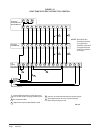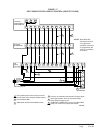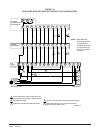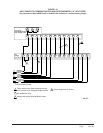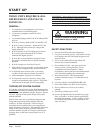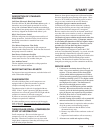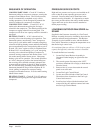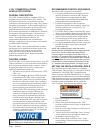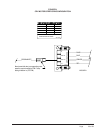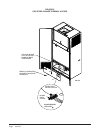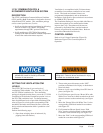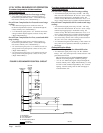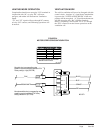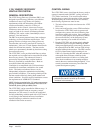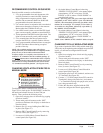
Manual 2100-549G
Page 34 of 59
I-TEC
COMMERCIAL ROOM
VENTILATOR SYSTEM
GENERAL DESCRIPTION
The I-TEC Commercial Room Ventilator (CRV) is
designed to be used with all Bard I-TEC models. The
only intent of this device is to provide the required
ventilation by delivering fresh air to meet I.A.Q. (Indoor
Air Quality) requirements. In the installed application,
this system also includes exhaust provisions which are
balanced with the intake air to maintain building
pressurization requirements of ASHRAE 62.1 Standard.
Ventilation is accomplished with (2) blower/motor
assemblies for maximum ventilation at low sound
levels. The intake and exhaust blowers are
programmed independently and are balanced to
maintain a slight positive pressurization in accordance
to ASHRAE 62.1 Standard.
The I-TEC CRV is also provided with filters to reduce
the required service needed and to further improve the
I.A.Q. The exhaust air blowers are protected by
disposable filters, and the intake air blowers are
protected by washable filters. Both are accessible
without the need for tools.
CONTROL WIRING
The I-TEC CRV comes wired from the factory set to 375
CFM of ventilation. Care must be taken when deciding
how to control the operation of the ventilator. When
designing the control circuit for the ventilator, the
following requirements must be met.
1.
The indoor blower must be run whenever the I-TEC
CRV is run.
2. Select and configure the correct CFM ventilation
level that the I-TEC CRV needs to operate and
configure the system to this level following later
instructions within this section. Over ventilating
serves no useful purpose and significantly affects
the overall efficiency of the heat pump system.
System operating costs would also increase.
3. Run the I-TEC CRV only during periods when the
conditioned space is occupied. Running the
ventilation during unoccupied periods wastes
energy, decreases the expected life of the CRV,
and can result in large moisture buildup in the
structure. Running the CRV when the structure is
unoccupied allows moisture to build up in the
structure because there is little or no cooling load.
Thus, the air conditioner is not running enough to
remove the excess moisture being brought in. Use
a control system that in some way can control the
system based upon occupancy.
RECOMMENDED CONTROL SEQUENCES
Several possible scenarios are listed below:
1. Use a programmable electronic thermostat with
auxiliary terminal to control the CRV based on
daily programmed occupance periods. Bard
markets and recommends Bard Part #8403-060
programmable electronic thermostat.
2.
Use Bard CompleteStat™ that incorporates
temperature, humidity and occupancy control with
learning capability into a single device. No
programming required.
3.
Use a DDC control system to control the CRV based
upon a room occupancy schedule to control the CRV.
4.
Tie the operation of the CRV into the light switch. The
lights in a room are usually on only when occupied.
5. Use a manual timer that the occupants turn to
energize the CRV for a specific number of hours.
6. Use a programmable mechanical timer to energize
the CRV and indoor blower during occupied
periods of the day.
NOTE: The ventilation package comes with a blower
interlock function, but is disabled when it is shipped from the
factory in case you do not utilize a thermostat with an
occupancy output, or a occupancy sensor and must tie "A"
terminal to "G" terminal to drive the ventilation package. If
you
do have a thermostat or control that does drive occupancy
output, you will need to remove the tape from the orange wire
located in the low voltage terminal box, and connect it to the
"G" terminal to activate this function. (See Figures 13-19.)
SETTING THE VENTILATION CFM LEVELS
The I-TEC CRV has four pre-set levels of ventilation
CFM available. These are 300, 375, 450 and 525 CFM of
ventilation air. The I-TEC CRV is shipped from the
factory set on the 375 CFM ventilation level. To change
between these four different levels of provided ventilation
CFM, first refer to Figure 21 to look up the corresponding
CFM needed for the intake and exhaust blowers to meet
the design criteria and determine which “speed/wire
color” is needed. Then, perform the following steps.
1.
Open front swinging doors of main unit (by popping
front door latches).
2. Throw main power disconnect to the
“
OFF
”
position to eliminate risk of injury or death due to
electrical shock.
3. Remove six (6) screws holding front CRV door in
place (See Figure 22).
4. Locate
“
Brown Wire with White Trace
”
that has
a black terminal on the end where it connects to
the terminal strip (See Figure 21).
5. Move
“
Brown Wire with White Trace
”
to the
corresponding CFM level needed in accordance
with Figure 21.
Operating the I-TEC CRV during unoccupied periods can
result in a build up of excess moisture in the structure.
SUPPLIES BEFORE SERVICING.
!
HAZARD OF ELECTRICAL SHOCK.
ELECTRICAL SHOCK CAN RESULT
7961-754-2
WARNING
IN SERIOUS INJURY OR DEATH.
DISCONNECT THE REMOTE
ELECTRIC POWER SUPPLY OR



